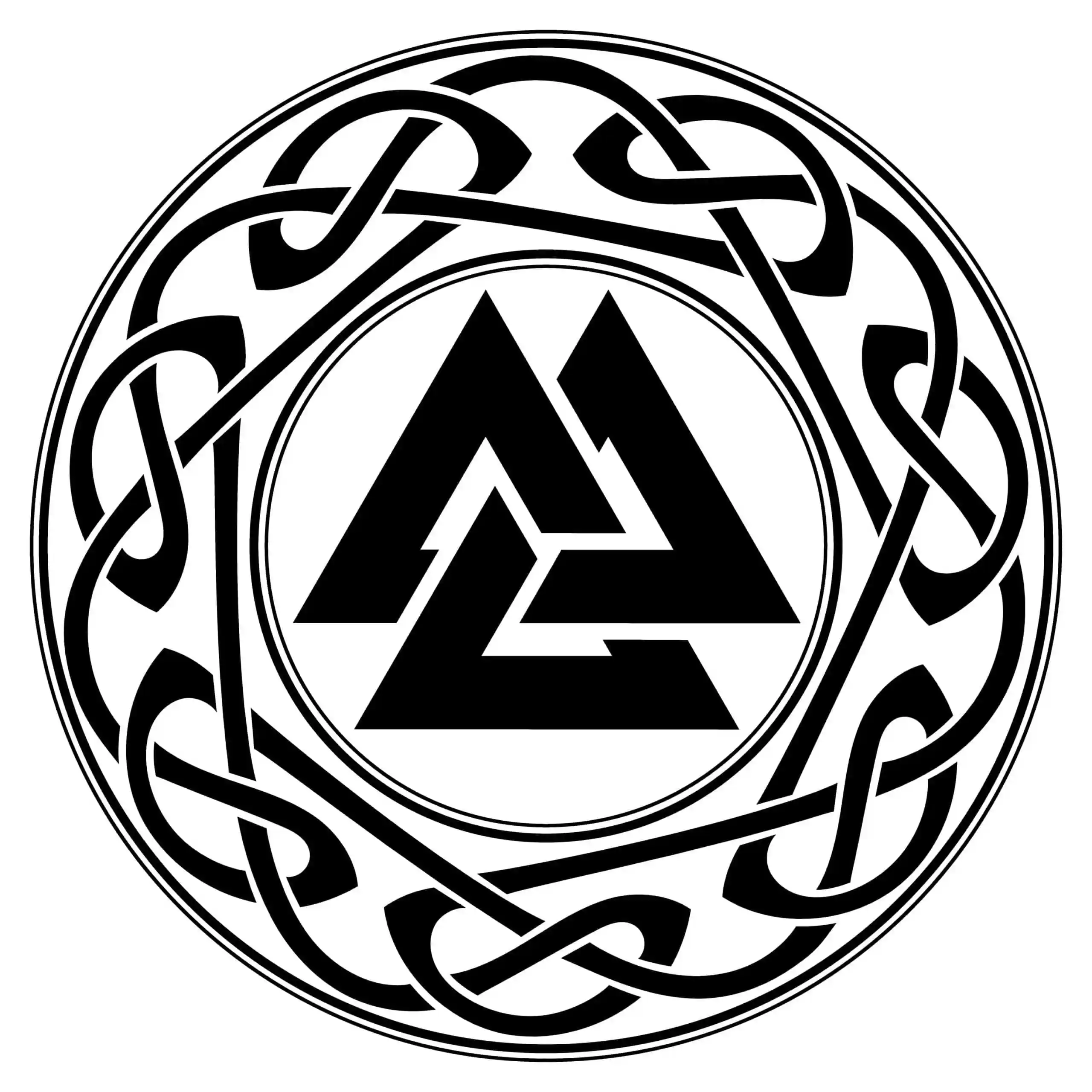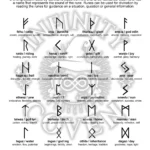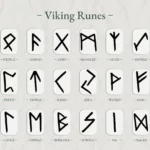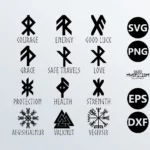Unravel the mysteries of the Vikings! These ancient Nordic warriors left behind a legacy of intriguing symbols called runes. Join us on a thrilling adventure to decipher their hidden meanings, from their spiritual significance to their use as practical tools. Prepare to immerse yourself in the captivating tales and profound wisdom encoded within these enigmatic characters, offering a captivating glimpse into the psyche and beliefs of the enigmatic Vikings.
Viking Runes: Ancient Symbols of Power and Mysticism
Picture this: Centuries ago, the Vikings, fierce seafarers and warriors, used a unique set of symbols called runes. These were more than just letters; they were imbued with profound meaning and wielded mystical power.
Runes served as the alphabet for the Norse people, but their significance extended far beyond communication. They were a potent force in their lives, used for divination, magic, and connecting with the gods. Vikings carved runes on amulets to ward off evil, on stones to guide their journeys, and on weapons to invoke strength and victory.
Just like any language, runes were organized into groups called “aettir” or families. Within each family, eight runes shared similar themes and meanings.
Freyr’s aett represented prosperity, vitality, and safety. It included runes like “Fehu” (wealth), “Uruz” (strength), and “Thurisaz” (protection).
Hagal’s aett symbolized resilience, wisdom, and shielding against the unpredictable. Runes like “Hagalaz” (hail), “Nauthiz” (hardship), and “Eihwaz” (protection) belonged to this family.
Tyr’s aett stood for justice, triumph, and the power of speech. It encompassed runes such as “Tiwaz” (justice), “Sowilo” (victory), and “Inguz” (fertility).
Each rune held its own unique essence, shaping events and guiding the Vikings in their everyday lives. Understanding these ancient symbols grants us a glimpse into the Vikings’ beliefs, values, and the rugged world they navigated.
Explore the Table of Viking Runes:
| Rune | Name | Meaning |
|---|---|---|
| ᚠ | Fehu | Abundance, prosperity |
| ᚢ | Uruz | Strength, vitality |
| ᚦ | Thurisaz | Protection, defense |
| ᚨ | Ansuz | Communication, guidance |
| ᚱ | Raidho | Travel, adventure |
| ᚲ | Kenaz | Fire, inspiration |
| ᚷ | Gebo | Partnership, connection |
| ᚹ | Wunjo | Joy, harmony |
| ᚺ | Hagalaz | Challenge, transformation |
| ᚾ | Nauthiz | Perseverance, resilience |
| ᛁ | Isa | Pause, reflection |
| ᛃ | Jera | Completion, harvest |
| ᛇ | Eihwaz | Protection, endurance |
| ᛈ | Pertho | Fate, destiny |
| ᛉ | Elhaz | Strength, protection |
| ᛜ | Sowilo | Success, victory |
| ᛏ | Tiwaz | Justice, balance |
| ᛒ | Berkana | Growth, potential |
| ᛖ | Ehwaz | Change, movement |
| ᛗ | Mannaz | Self-awareness, intellect |
| ᛚ | Laguz | Intuition, flow |
| ᛝ | Inguz | Creation, fertility |
| ᛞ | Dagaz | Transformation, new beginnings |
| ᛟ | Othala | Legacy, heritage |
Delving into the world of Viking runes is like uncovering a hidden treasure. They connect us to a bygone era, revealing the beliefs and aspirations of a people who left an enduring legacy in the annals of history. Explore these ancient symbols, and let their power and enchantment guide you on your own path.
Do you want to learn the ancient secrets of rune symbols and meanings? Delve into the enigmatic world of Norse runes and discover the profound significance they hold in rune stone meanings. Explore the rich tapestry of runes and meanings, unlocking the wisdom and power embedded within these ancient symbols. Embark on a journey through the mystical realm of futhark runes, where the secrets of the universe lie intertwined.
Exploring the Phonetics and Symbolism of Viking Runes
Imagine stepping back in time to the Viking era, where warriors and explorers left behind a legacy of enigmatic symbols known as runes. These weren’t just letters; they were a sacred language that spoke volumes about the Norse culture.
Fast-forward to today, and runes still captivate our imagination. Let’s delve into their intriguing world and uncover the secrets of their sounds and meanings.
Rune Wheel: A Map of Phonetics and Symbolism
Picture a circular chart, the Rune Wheel. Each rune occupies a specific spot, representing both its phonetic value and a profound concept. The Vikings believed these symbols held mystical energies that guided their lives.
Elder Futhark and Younger Futhark: Rune Alphabet Evolution
Over time, the Viking alphabet evolved into two main versions: the Elder Futhark and the Younger Futhark. The Elder Futhark dates back to the 2nd century CE and consists of 24 runes. As the Vikings spread across Europe, they adapted their alphabet to local languages, creating the Younger Futhark with a total of 16 runes.
Rune Meanings: Unraveling the Symbolism
Each rune holds a distinct meaning that reveals a facet of Viking culture. For example:
- Fehu (Wealth) represents cattle, prosperity, and possessions.
- Uruz (Strength) embodies the untamed power of the aurochs, a wild ox.
- Thurisaz (Thorn) symbolizes defense, challenges, and the power to ward off evil.
Runes in Practice: A Versatile Tool
Beyond writing, runes were used for various purposes:
- Protection: Vikings inscribed runes on amulets and talismans to safeguard themselves.
- Divination: Runes were cast as a form of divination, providing guidance and insight.
- Commemoration: Runestones were erected to honor fallen warriors and mark important events.
Modern-Day Enchantment with Runes
Today, runes continue to enchant enthusiasts and artists alike. From tattoos and jewelry to books and art, these ancient symbols find new expressions, keeping the Viking legacy alive.
So, next time you encounter a mysterious rune, pause and reflect on the rich tapestry of sound and symbolism woven into its history. Runes are a testament to the ingenuity and spiritual depth of the Viking civilization, connecting us to a world both ancient and enchanting.
Decoding the Secrets of the Rune Wheel: A Cycle of Life and Beyond
Imagine the Rune Wheel as a roadmap, a blueprint of life’s journey as seen through the eyes of the ancient Vikings. Each rune, a symbol inscribed on wood or stone, carries its own unique meaning, like a piece of a puzzle.
The Rune Wheel is a reflection of Viking culture, woven into the very fabric of their life. It’s not just a writing system; it’s a window into their beliefs, their hopes, and their connection to the unseen.
Unveiling the Mysteries of Runes
Picture the Rune Wheel as a circle, representing the never-ending cycle of life and death. Within this circle, three families of runes dance: Freyr’s aett, Hagal’s aett, and Tyr’s aett. Each rune symbolizes a different aspect of life’s tapestry.
Fehu, the first rune of Freyr’s aett, whispers of prosperity and wealth. Uruz, from the same family, roars with the power of strength and courage. Ansuz, from Odin’s own aett, beams with the wisdom of knowledge and communication.
A Guide for Life’s Journey
As you move through the Rune Wheel, the runes become your guideposts. Raidho, the wanderer’s rune, urges you to embrace change and adaptation. Inguz brings forth the seeds of new beginnings and potential. And Eihwaz, the evergreen yew tree, whispers of endurance and resilience.
The Rune Wheel’s Timeless Message
The Rune Wheel is a timeless treasure, a reminder that life’s journey is a cycle, forever evolving. Its runes hold secrets that can guide us through our own adventures, reminding us of the power within us and the interconnectedness of all things.
As you delve deeper into the world of runes, may their wisdom illuminate your path, empower your spirit, and enrich your understanding of life’s grand tapestry.
Unveiling the Distinction: Viking Runes vs. Nordic Symbols
You’ve heard of Vikings and their horned helmets, but what about their secret signs? Viking runes were more than just a way to write—they were a mystical code connected to gods and fate. But don’t mix them up with Nordic symbols, which were cool designs that represented their beliefs and protected warriors.
Viking Runes: The Alphabet of the Norse
Imagine a secret alphabet where each letter has a name and a special meaning. That’s Viking runes! They were used to write messages, but they were also symbols of things like wealth, protection, and new beginnings. The Rune Wheel, where all the runes were arranged, was like a map of the universe according to the Vikings.
Nordic Symbols: Visual Tales of Gods and Heroes
Nordic symbols weren’t like runes. Instead, they were pictures that told stories about gods, mythical creatures, and important events. The Valknut, for example, shows Odin’s power, while the Vegvisir was like a Viking compass, guiding them through storms. These symbols weren’t just for show—they were like amulets, protecting warriors and bringing good luck.
Similarities and Differences
- Similarities: Both runes and symbols were connected to Norse culture and mythology.
- Differences: Runes were an alphabet, while symbols were visual representations of ideas. Runes were used for practical things like writing and divination, while symbols were mostly decorative and protective.
Conclusion
Viking runes were a powerful writing system and a window into Norse beliefs. Nordic symbols, on the other hand, were artistic expressions of their values and a way to connect with their gods. Understanding the difference between these two helps us appreciate the richness and depth of Norse culture.
FAQ
Q1: What are Viking rune symbols and what did they represent?
A1: Viking rune symbols were the alphabetic system of the Norse, an ancient writing script used to represent sounds and form words. These symbols carried profound mystical and magical significance in Norse mythology, representing various ideas such as courage, fate, gods, and aspects of daily life.
Q2: Can you provide some examples of Viking rune symbols and their meanings?
A2: Examples of Viking rune symbols and their meanings include:
- Raidho (movement)
- Tiwaz (warrior)
- Wunjo (joy)
- Uruz (strength)
- Thurisaz (protection)
- Sowilo (sun)
- Pertho (fate)
- Othala (heritage)
Q3: How did Viking runes influence the English language and alphabet?
A3: Norse runes influenced the development of English letters. The runes Fehu, Othila, Sowilo, and Tiwaz evolved into the English letters F, O, S, and T, respectively.
Q4: What is the significance of the Rune Wheel in Viking culture and beliefs?
A4: The Rune Wheel, featuring the Viking rune symbols, is a circular representation of Viking beliefs and values. It reflects the cycle of life and death in Norse mythology, and each symbol in the wheel holds its own unique meaning and significance.
Q5: What practical and spiritual uses did Vikings have for runes beyond communication and writing?
A5: Beyond practical uses such as writing and communication, Vikings also attributed mystical powers to runes. They used them for divination, protection, and various spiritual rituals. Runes were believed to embody the power of the gods and the forces of nature, and were often carved into amulets, weapons, and other objects for protection and guidance.
- Senior at What Age: Benefits & Eligibility Guide - March 29, 2025
- Unlocking Senior Benefits: How Old is a Senior? Your Complete Guide - March 29, 2025
- Master Russian Politeness:A Guide to Saying Please - March 29, 2025
















